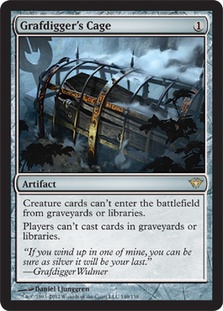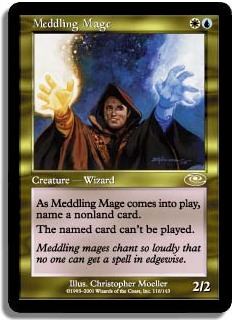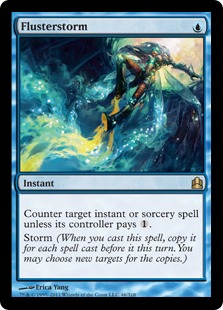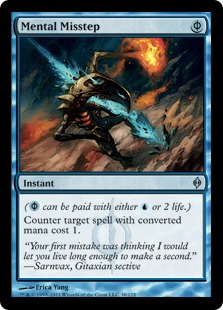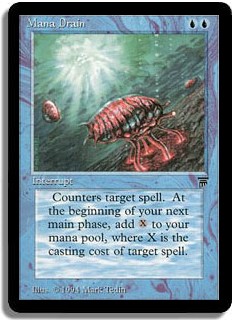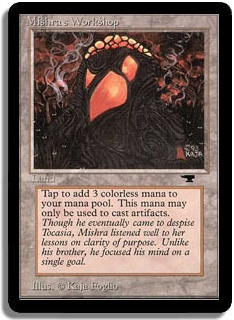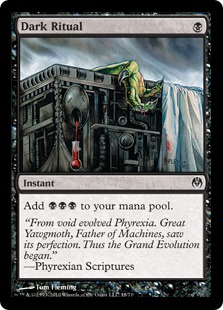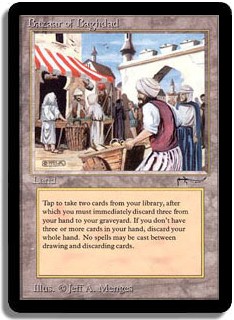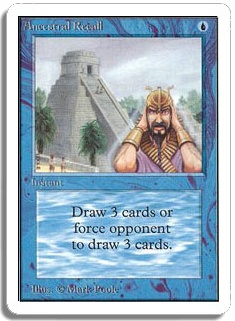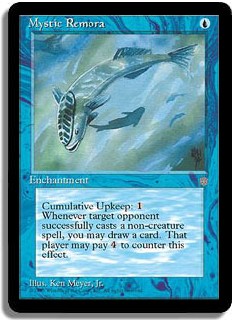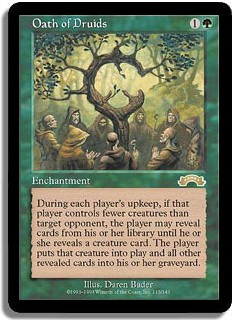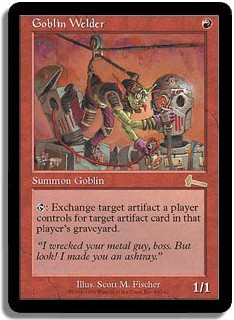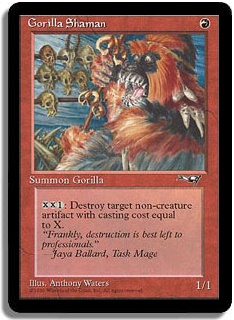Vintage has become overrun by hordes of creatures and not just the usual suspects—Dark Confidants, Lodestone Golems, and Blightsteel Colossuses; a plethora of new decks whose plans are to play creatures and bash into the red zone have emerged in the past month! I have talked at length with other Vintage experts who have also taken notice of this emerging trend, and the consensus response to the sustained surge of Vintage players winning with creatures appears to be surprise on the one hand and on the other, confusion and desire to understand the apparent restructuring of the Vintage metagame.
Oh, and also no big deal, but the following card has been confirmed for Dark Ascension, the upcoming Magic expansion:
Translation: “From here on out, EVERYBODY PLAY FAIR!”
In this week’s article, I am going to investigate and give you my take on the following important questions that I think are at the heart of the new popularity of creature decks in Vintage:
I. Why now are we seeing the renaissance of the creature deck in Vintage?
II. Is this surge in creature decks sustainable?
III. Where the heck is the metagame heading???
INTRODUCTION: VINTAGE MASTER’S CLASS
- Observations from Chris Pikula.
- Arguing with Stephen Menendian.
- The Nail in the Coffin.
A. OBSERVATIONS FROM CHRIS PIKULA
I would first like to draw your attention to a post from Chris Pikula on www.themanadrain.com last week:
“…Which permutation of counterspells is best completely depends on what you are paired against that day. Flusterstorm and Mental Misstep are insane against some decks, trash against another. It used to be that I could play counterspells and gain versatility while sacrificing efficiency and also agreeing to be a reactive than proactive deck. Now rather than make counterspells versatile, they have chosen to make them narrow and efficient. I used to think that, because I was a better player than most of my opponents, I could pack my deck with versatile spells, and this worked to my advantage. I was playing way more Nature’s Claims and Fire / Ices in my Tezz decks 2 years ago (or whenever it was) because I felt like having versatile tools gave me an edge. Now because they have printed so many very narrow but very efficient spells, it feels like my flexible answers just aren’t good enough anymore. I feel like I’m being forced, to an extent, to decide who I want to blow out and who I want to be blown out by game 1.”
“The Meddling Mage posts so loudly that I couldn’t help but notice how spot-on his insight was…”
In the past few years, Vintage has gotten a whole slew of new and powerful playable utility cards, and the effects of these cards in the long term are only now becoming apparent. Two cards in particular: Mental Misstep and Flusterstorm come most quickly to mind.
These two cards have very quickly emerged as format-shaping, hyper-efficient spells that have literally changed the way that games of Vintage look, feel, and ultimately play out. If we look back to how people understood Vintage three years ago, we would certainly encounter a discussion of the ‘Pillars of Vintage’; do you remember these: Mana Drain, Dark Ritual, Mishra’s Workshop, and Bazaar of Baghdad?
“Some of these ‘pillars’ have, shall we say, crumbled?”
If you are curious as to the complete annihilation of the entire ‘pillar’ of Dark Ritual (and the waning popularity of Mana Drain also) from the Vintage metagame, you literally need to look no further than the printings of Mental Misstep and Flusterstorm as an explanation for why.
But, to get back to Chris’s observation: I share his sentiment that when playing Vintage, I too am just looking for a deck that ideally has a 50% matchup against everything in the field and lets my play and in-game decision-making put me over the edge one way or another. The time-tested formula of playing a blue X combo-control deck with versatile cards has historically proven to be the best way to achieve such an objective (you need only observe my complete subscription to and sustained success with plodding Control Slaver decks as evidence of this theory in practice). But what if that simply isn’t the case anymore, and what if blue X spell decks no longer provide us this option?
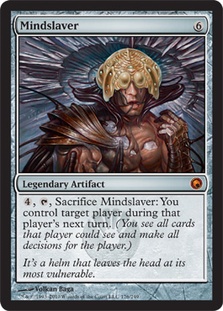
“Back in the day, we used to control everybody’s turn together…”
B. ARGUING WITH STEPHEN MENENDIAN
I have been having an ongoing debate with fellow Meandecker Stephen Menendian for nearly a decade on a number of topics regarding the banned & restricted list and what kind of environment affords players with the best possible Vintage format.
One recent subcategory of debate we recently had regarding Vintage is about whether it is a good or bad thing to have a deck that has a 50% matchup against the entire field in Vintage. It is kind of an abstract argument, but bear with me here:
I stated in a conversation that when I am building a deck to play in a Vintage tournament, all that I am trying to do is create a combination of 75 cards where no matter what 75 cards my opponent is playing, in the dark and assuming perfect play on both sides, I will have a 50% matchup—and ultimately my decision making and format knowledge will invariably give me advantage.
Steve’s snap response to that statement was: “Such a deck would be broken and extremely undesirable to exist in the format.”
I responded with the question: “How can a deck that only wins half the time against anybody be broken? If you played against a comparable opponent every round, you would go 4-4 in every big tournament?”
Steve responded: “Decks SHOULD have good AND bad matchups, which is a fundamental part of Magic and deck selection theory. A deck that has no bad matchups and only good matchups would dominate the metagame and would always be the best deck.”
Me: “But such a deck would also have no FAVORABLE matchups against an anticipated deck. Imagine this situation: I have a deck in front of me that has a 75% matchup against Workshops, 40% matchup against Vintage Control, 60% matchup against Oath of Druids, 25% matchup against Dredge, 50% matchup against Fish, and so on and so forth. Wouldn’t such a deck have roughly a 50% matchup against the field—and if this were the case and I anticipated, or could reasonably predict, that there would be more Oath of Druids and Workshops (good matchups) in an expected metagame than, say, Dredge and Vintage Control, that such a deck would have a greater than 50% matchup against the expected field?”
Stephen: “Yes, true. But the fact of the matter remains the same: you still run the RISK of playing against your bad matchups—perhaps less often than your good ones, but you still might play against them.”
Me: “Doesn’t that simply create a situation that is defined by variance and the luck of the draw with regard to pairing? For the sake of argument: what if I had a deck that was 75% against Workshop, 75% against Gush, 50% against control, 75% against big blue, 50% against Oath of Druids, and 25% against Dredge, and 25% against miscellaneous aggro/fish decks. But I know going into the tournament that Workshop, Gush, and Big Blue are likely to account for 70% of the field; once it is all said and done, wouldn’t such a deck have a match-win percentage approaching 65% against ‘the field?’ How can it be that a deck that has a 50% matchup against the field be broken, when it would be acceptable to have a deck with a 65% matchup against the field?
Now imagine that I had such a deck in my pocket, and I start messing with the numbers of cards in it. What if I swap out some of my maindeck cards and sideboard cards that are good against Blue and Workshop for ones that are good against Fish, Oath, and Dredge? Wouldn’t it make sense that I could sacrifice percentage against my good matchups to bolster my bad ones? It seems perfectly plausible to me that it is actually pretty easy to create a deck that has all 50% matchups against the field if you work at it a little bit.”
And then this conversation continued on for another hour and a half…
Here’s the joke: I don’t even think that a deck that has a 50% matchup against every deck is very good because, you need an 80% match-win percentage to top eight an event. More realistically, in order to top eight a tournament, one wants to be playing a deck that has closer to a 65% matchup against whatever combination of decks they are most LIKELY to play against; and then on top of that they probably need to get a little bit lucky and play better than their opponents.
Why is this discussion relevant to my discussion of CREATURES, CREATURES, EVERYWHERE!? I’m getting to that, so bear with me.
Chris Pikula observation was that because of the emphasis of situational ‘blowout’ type cards (Flusterstorm, Mental Misstep, and Spell Pierce for example), Vintage was becoming more matchup dependent. Essentially, you pick who you want to blow out and who you want to get blown out by and hope to get the pairings that favor your good matchups.
Let me preface the following discussion by saying the following: I have had the great pleasure of talking and playing Vintage with Chris, and I would put him into a unique and special class of skilled Vintage players. He is literally among the best of the best with regard to his understanding of how Vintage works and his ability to build and play at the highest level. If I could pick a five-man Vintage All-Star team, he would be in my five.
With that being said: I can relate to his observation that the format is much more matchup dependent than it used to be and that simply playing with utility cards and playing better than people doesn’t afford good players the same kind of mileage as it used to.
I am going to go out on a limb here and state that:
Stephen Menendian is the kind of player who likes to roll the dice and has no problem jamming a Doomsday combo deck with a 25% matchup against Workshop and 80% against everything else when he knows Workshop will only be 20ish% of the field. Chris Pikula is more the type of player who is not looking for a deck with a bunch of blowout matchups but more or less a deck with no bad matchups.
There is nothing wrong with either perspective or way of solving a metagame; however the latter is much more in tune with my style of trying to solve it. I like to put the emphasis on strong play to win my matches rather than on my pairings to do the work for me.
Here is the conclusion that all of this discussion is boiling down to:
What if we have reached a point where the Big Blue Combo/Control decks can no longer be built to have a 50% matchup against the field, as they traditionally have been?
C. THE NAIL IN THE COFFIN
Big Blue in its various iterations has almost always emerged as the best deck in Vintage. Think about it: Keeper, BBS, GAT, Psychatog, Control Slaver, Meandeck Gifts, GAT, Tezzeret Control, GAT, Vintage Control, and GAT.
Why?
“I have a migraine trying to figure out why anybody would choose to play Mishra’s Workshop!”
There are a lot of reasons; most of them revolve around the fact that blue cards are insane.
However, there is another really important reason that often gets overlooked: Big Blue decks are also the most versatile and most difficult to hate out because their strategies are resilient, and their cards are so good.
For instance, when sideboarding, what have people traditionally brought in against popular decks: Against Dredge, people bring in Leyline of the Void; against Workshop they bring in Ancient Grudge; against Storm they bring in Ethersworn Canonist. These are cards that are really, really disruptive to linear strategies and can simply win games virtually by themselves.
What do people bring in against GAT? Red Elemental Blast? Duress?
It is the best we have had, but Pyroblast on an opponent’s Merchant Scroll doesn’t exactly end the game or cripple them necessarily.
Here is what has changed:
This is the world we live in now.
These are simply the best maindeckable answers to blue decks that have ever been printed for Vintage. And because everyone and their mom is playing these cards, the arms war continues, and people are playing:
Ice Age quality at its finest.
There are more of these types of blue blowout cards being played in Vintage than I have ever seen at any point in the history of the format. The fact that things are like this is obviously a direct result of these cards recently seeing print. However the types and quantity of these cards change one blue player’s matchup against other blue decks pretty drastically.
This is the exact phenomenon that Chris Pikula is pointing out in his post: if he wants to hedge his matchups against Workshop, Fish, Dredge, or whatever by playing versatile cards like Fire / Ice or Nature’s Claim, he is drastically sacrificing his blue matchup, especially against the super-hater who is maindecking 4 Mental Misstep, 4 Mystic Remora, and 3 Flusterstorm! Seriously, that is a HATEFUL mix.
The blue matchup is actually what is killing the blue deck!
There are so many options and so much room to go to the extreme to beat it that depending upon how much or how little you gear up to beat it, you can be either a far-end underdog or far-end favorite. Since blue decks continue to be the most popular and most played, it really creates a situation where you must address the matchup, probably at the expense of sacrificing percentages against other archetypes.
The problem isn’t that the big blue cards are not awesome, but the issue here is that recent printings have given decks the tools to create a big gap in the blue matchup depending upon how you build your deck.
The biggest problem that is crippling the blue decks is that the mirror match isn’t just assumed to be 50%, and the better mage will outplay and win. You can’t consistently outplay a guy with Remora, Flusterstorm, and Mental Misstep with a Blue deck full of Fire / Ice, Ancient Grudge, and Nature’s Claim.
Here is what I figured out two weeks ago when I sat down and thought about how to build a blue deck that beats the blue mirror. You assume that they are focused on doing the busted things: Tinkering, Yawgmoth’s Willing, and Key-Vaulting, and then you focus on stopping them. You also assume that they are going to be focusing on stopping you from doing the same thing, so you simply don’t do the same thing that they are trying to do.
So instead of fighting the mirror along the same old line, you instead play with creatures, stop them from executing strategically, and grind them to death.
It is my opinion that the best decks against the field right now, and possibly moving forward, may no longer be big blue all-spell decks; I believe that playing with creatures is going to be the future of the elite blue decks in Vintage.
Will the Cage help creature decks ‘lock up’ matchups where they have struggled in the past?
(I will be talking at length about the Cage in the DKA Vintage Set Review that Mark Hornung and I are working on for next week; so tune in … there is a lot to be said.)
I. WHY ARE WE SEEING A RENAISSANCE OF CREATURE DECKS IN VINTAGE RIGHT NOW?
Creatures are everywhere in Vintage; the format is literally infested with them.
Big creatures, little creatures, beaters, utility monsters, hate bears, and creatures that are secretly spells… You name it, and somebody is probably playing it somewhere.
The reason, which I will reiterate more succinctly right now, is:
Creature decks are seeing a reemergence in Vintage because the blue spell decks are being forced to spread themselves more thinly in order to compensate for the mirror match. Creatures, especially in blue decks, are really good right now because they tend to dodge the narrow anti-blue spell hate and also because they also appear to bolster other non-blue matchups!
Playing with this guy sends your opponent a subtle message: “Kiss my ass, Mystic Remora and Mishra’s Workshop.”
Here is another fact: creatures like Trygon Predator are not donkey beaters like Tarmogoyf; Trygon is a spell on legs (but without wings, which is strange because it flies).
Let me clarify something: when I say I like creatures in Vintage right now, I don’t mean that I like Kird Apes, Wild Nacatls, and Tarmogoyfs specifically (although with where things are headed who knows what could happen…). I mean I like creatures that function like spells and are versatile like spells.
The understanding that creatures that act like spells are really good in a format that is bending over backwards to attack people who cast non-creature spells is what led me to build the Bant Midrange deck.
Here is my revised, pre-Grafdigger’s Cage build of that deck:
Creatures (11)
- 2 Trygon Predator
- 1 Tarmogoyf
- 2 Noble Hierarch
- 1 Qasali Pridemage
- 2 Stoneforge Mystic
- 1 Scavenging Ooze
- 2 Snapcaster Mage
Planeswalkers (2)
Lands (16)
Spells (31)

If you notice one thing about this deck, it should be the following: My creatures are all actually spells, whose abilities help me shut down my opponent’s ability to win.
Scavenging Ooze is a Tormod’s Crypt.
Qasali Pridemage is a Disenchant.
Stoneforge Mystic is a Tinker.
Noble Hierarch is a Mox.
Trygon Predator is an Isochron Scepter on Disenchant.
Such a deck is really, really good at blanking and fighting blue decks that are focused on beating the other blue decks. I have all of the good cards that stop blue decks—Flusterstorm, Mental Misstep, and Mystic Remora. However, I also have cards like Scavenging Ooze to attack Yawgmoth’s Will, Pridemage to attack Key-Vault combo, and Trygon to attack their mana.
It also just so happens that the creatures, while good against the blue spell decks, are randomly actively great against other decks like Workshop. Dredge is obviously tough and demands a lot of sideboard cards, but this is actually a strategy that meets my criteria of all passable matchups against an expected field.
The same can be said about Gush decks that are packing Tarmogoyfs, Dark Confidants, and Trygon Predators.
I don’t love Tarmogoyf because the only attribute of the game he affects is the combat step—but, he does do that very, very, well. Nonetheless, creatures popping up in blue decks is a trend that is only going to become more and more popular moving forward. They are good on their own, and they are a nice compliment to blue cards since they add the dimension of having impactful combat choices to the utility that blue decks are already actively afforded.
II. IS THIS SURGE OF CREATURE DECKS SUSTAINABLE?
When I first set out to write this article, I wasn’t sure exactly how I felt about whether creature decks were here to stay forever or just good for now. Grafdigger’s Cage makes me think that it is almost certain that creatures have now solidified their place as a tier one strategy in Vintage forever.
The big question mark hovering around what role and how predominant creatures are going to be moving forward is exactly the subject that Mark Hornung addressed in his article last week:
“The longstanding Bane of the Creature Deck in Vintage.”
Oath is pretty much without a doubt the biggest predator of creature decks in Vintage, as it directly punishes an opponent for having a creature in play by cheating out some gigantic, ridiculous monster.
Yes, I know, I know, the Cage—but still, you have to draw it and resolve it. I’m pretty sure that Cage or no Cage in your deck, if you are battling with a bunch of creatures, one of the worst-case scenarios for you is that your opponent slams an Oath of Druids into play.
Nonetheless, I don’t actually think that Oath of Druids is some unbeatable matchup for creature decks. The Bant deck I played had three Nature’s Claims in the board, for instance. Oath is going to have draws that are difficult to beat when they get their enchantment down on the first turn, but at the very least I think that predominance of Oath will be little more than a metagame consideration for when and how many creatures decks choose to play.
Keep in mind it isn’t like Oath decks have don’t have Forbidden Orchard and Beast Within to FORCE people to have creatures so they can execute their strategy.
Oath is obviously a factor. If something crazy like half the field have the card, you’d be a fool to sleeve up Delver of Secrets—and there are a number of other limiting factors that are likely to keep Oath in check.
Firstly, I predict that Grafdigger’s Cage will see a lot of play out of the gate, especially in Workshop and creature decks—which have traditionally been the #1 Reason to play Oath of Druids.
Secondly, the Oath of Druids mirror match is one of the most miserable matchups I can possibly imagine. Personally, I would not play Oath if there was a significant chance I’d have to play the mirror.
Perhaps even more important for the sustainable future of creatures in Vintage is: how are the big blue decks going to respond to the changing field?
The problem with trying to make your blue deck better against creatures is two-fold. First of all, blue decks don’t have a lot of wiggle room to actually play more cards to deal with people’s random creatures. Pretty much every single deck in Vintage makes the commitment to playing with a sideboard to beat Dredge, which means that the odds of people showing up and “really meaning it” with regards to punishing people for playing their creatures seems marginal.
Most blue spell decks play MAYBE two cards to kill a non-artifact creature out of their sideboard. Usually a couple of Dismembers or Doom Blade, which is fine, but when the creature decks are also trying to Gush, Jace, Tinker, or Yawgmoth’s Will in addition to attack with a Tarmogoyf or Trygon Predator, it forces a player to really pick their battles.
What Gush deck has room to pack Pyroclasm these days? And even if they did, how good would it actually be? It doesn’t kill Goyf, Trygon Predator, or a creature wearing a Sword; although it has a high opportunity to kill Noble Hierarch, Snapcaster Mage, Dark Confidant, and Delver, if you get more than one at a time.
Is it time to live the dream and summon a river of lava?
My conclusion here is that playing with creatures in any and every archetype is the way of the future.
III. WHERE IS THE METAGAME HEADING?
For the first time, I think that I can honestly say creatures are actually among the best strategies in Vintage, and that is just the way it is. You don’t have to jump through hoops or play a bad deck or have a bunch of unwinnable matchups in order to utilize the attack step with something that didn’t get Tinkered out; playing with creatures is good, and that is good for Vintage.
Now, just because creature decks are finally a realistic, sustainable option to play in Vintage doesn’t mean that decks without creatures are suddenly bad. I think that cards and strategies like Gush, Yawgmoth’s Will, Tinker, and Time Vault have proven that they are the elite of the elite strategies, and I don’t believe that this is going to change moving forward.
Do I think that the elite strategies are going to incorporate creatures into their arsenal of powerful, versatile, and degenerate capabilities? Oh, yeah.
Do I think that the emergence of lots of creatures seeing play in Vintage is going to squelch non-creature decks from the face of the format? Hells no.
Keep in mind this isn’t the first time, nor will it be the last when playing with creatures is en vogue.
I played 4 Dark Confidant and 3 Quirion Dryad in my GAT back in the last iteration of the Gush metagame before it was restricted.
I played these guys in Slaver for years (speaking of which, it might be time to pair these fine fellows up once again in the near future):
“Mishra’s Workshop Beware!”
Owen Turtenwald and Bob Maher played Dark Confidant and Trygon Predator in their Time Vault deck when they met in the finals of the Vintage Championship two years ago.
It has been a long time coming that we have gotten to the point where it is simply be a known fact that creatures are awesome, and playing creatures is just as good as not playing with creatures.
One thing that I think is different now and moving forward is that creatures now can be good even if they don’t help you specifically execute Yawgmoth’s Will or Tinker. I think Grafdigger’s Cage really puts an exclamation point at the end of it.
Another intangible with predicting how things will be moving forward is how the Mishra’s Workshop decks adapt in order to utilize Grafdigger’s Cage to their advantage and how successful that archetype is playing with its new toy.
I will say this: the only time that Vintage actually approaches being fair is when everybody knows that Mishra’s Workshop is the best because when everybody knows that Shop is the best, it is pretty clear that it can’t actually be the best. As a contrast, when blue is the best for an extended period of time, look out because it’s 50-50 that the only way for things to change is to restrict something.
With that being said, I am really happy that Grafdigger’s Cage is a real, live card and that finally there is a respectable card that is good against a wide range of things that people can play IN THE MAINDECK that is also actively great against Bazaar of Baghdad. It’s been a long time coming, but I’m glad that such a card now exists.
Here are the three cards whose stock skyrocketed because of the Cage:
Would you like to know why? Tune into the Dark Ascension Vintage set review to find out. I am looking forward to talking much more about the Cage, along with all of the other interesting new Vintage playable cards, with Mark Hornung soon, so be sure to tune in for that.
Cheers,
Brian DeMars

